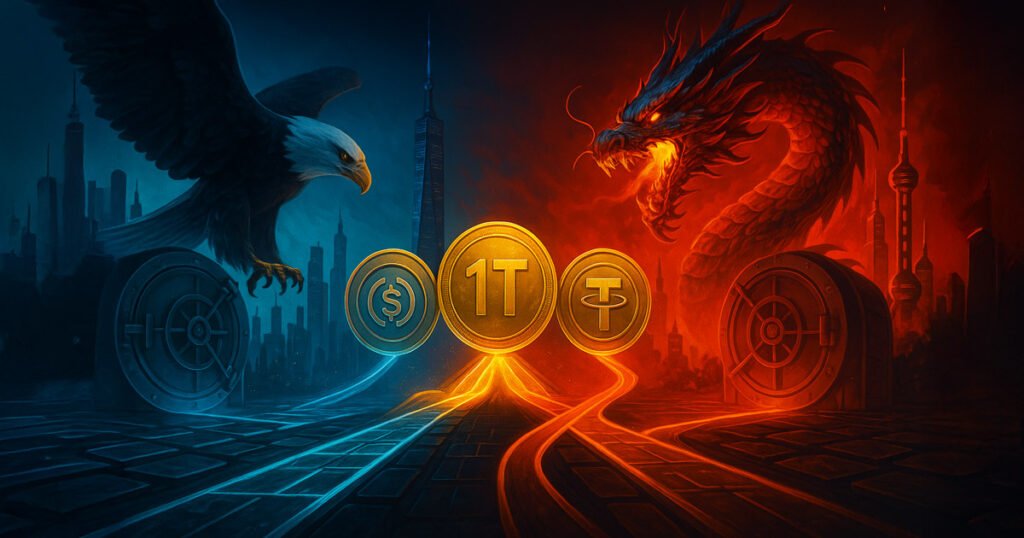The Race for On-Chain Payments: MetaMask’s mUSD, the EU Digital Euro, and Hong Kong’s AxCNH
The emergence of digital currencies has sparked a transformative competition among significant players in the global payment landscape. MetaMask’s mUSD, the European Union’s digital euro initiative, and Hong Kong’s offshore yuan token, AxCNH, are at the forefront of this contest. Unlike traditional trading volume metrics, the real prize lies in securing a share of the real-world settlement market, which could stand to reach a staggering $2 to $4 trillion annually. This growth hinges on the movement of just 1 to 2 percent of global cross-border payments onto tokenized platforms. With research from the IMF and McKinsey highlighting that the addressable base for cross-border activity is in the hundreds of trillions of dollars, even a modest market penetration over the next couple of years presents substantial opportunities.
The U.S. Dollar’s Advantage in Stablecoins
Historically, the U.S. dollar has maintained a significant advantage in the realm of stablecoins. Existing dollar rails benefit from established distribution channels within retail and developer workflows, making the transition to tokenization smoother. MetaMask’s mUSD leverages this infrastructure, utilizing Stripe’s Bridge for its issuance and employing M0 for its on-chain mechanics. Having launched in mid-September 2025 on Ethereum and Linea, mUSD incorporates wallet-level issuance and redemption seamlessly tied to existing card and merchant pathways. This integration minimizes settlement steps, creating a more efficient payment process. Furthermore, the U.S. has established a regulatory framework via the GENIUS Act enacted in 2025, which mandates that fiat-referenced tokens hold liquid reserves and provides a pathway for stablecoin issuers, further enhancing the dollar’s dominance.
Europe’s Digital Euro Strategy
In contrast to the U.S.’s approach, Europe has charted a distinct course with its digital euro, aiming primarily to lessen reliance on foreign card networks for retail transactions. The European Central Bank is pursuing legislation to facilitate this shift, with an implementation timeline projected for early 2026. Policymakers are addressing essential aspects like privacy concerns and bank funding risks, laying the groundwork for a multi-year implementation plan. The existing Markets in Crypto-Assets (MiCA) regulation has already established competitive guidelines, including transaction thresholds for non-euro stablecoins used within the Eurozone. These thresholds encourage merchants to favor euro-denominated instruments, signaling that the digital euro may swiftly become the standard payment method upon launch.
Asia’s Focus on Policy-Driven Stability
Hong Kong is introducing a different paradigm with its offshore yuan stablecoin, AxCNH. The issuance of AxCNH is crafted to align with local policies, particularly emphasizing corridor-based strategies that prioritize specific trade routes over global liquidity capture. While the Hong Kong stablecoin regime creates avenues for compliance and regulation, the prospects for scaling CNH tokens will depend significantly on the mainland’s stance on tokenization and market participation. Recent initiatives indicate a cautious approach from mainland regulators regarding the acceleration of digital currency adoption, emphasizing the necessity for structured compliance and regulatory frameworks to support the offshore yuan’s growth.
Market Capitalization vs. Transactional Flow
As the market for stablecoins evolves, market capitalization rather than transactional flow becomes the critical metric for assessing success. Currently, dollar-pegged stablecoins dominate the landscape with a market cap of approximately $291.7 billion, with Tether (USDT) accounting for around 59% of this share. Meanwhile, euro-pegged stablecoins and others are gaining ground but remain minor players in comparison. The impending question for MetaMask’s mUSD is whether it can leverage its embedded distribution model to accelerate growth faster than traditional exchange-led minting methods. Additionally, if Stripe’s robust merchant network can successfully bridge the gap between digital wallets and merchants, it may catalyze a shift in market dynamics toward new stablecoins.
Catalyst Factors: The Push to $1 Trillion
Achieving a market cap of $1 trillion is no small feat. Based on current trajectories, moving from a $291 billion baseline to a $1 trillion valuation within 12 to 24 months necessitates substantial annualized growth—approximately 240% annually over 12 months or about 126% over 18 months. Whether this growth is feasible will depend largely on product distribution and compliance readiness. Following the adoption of the GENIUS Act in the U.S., payment companies, card partners, and banks may find it easier to issue or distribute stablecoins, thereby accelerating growth. Furthermore, if payment processors initiate direct settlement using stablecoins, this could lead to a substantial inventory migration from exchanges to digital wallets, marking a pivotal shift in the payment landscape.
The Road Ahead: Regulation and Implementation Timelines
Regulatory frameworks play a crucial role in the realization of these digital currencies. The EU’s digital euro, slated for legislation and a multi-year buildout, is expected to roll out closer to 2027 or beyond. Meanwhile, Hong Kong’s AxCNH has launched with a regulatory compliance path, focusing on enhancing trade settlement capabilities. In this evolving landscape, the competitive edge will belong to those who can navigate regulatory requirements effectively while fostering market confidence in their digital currencies. As billions of dollars flow through on-chain payments, the stakes have never been higher for mUSD, the digital euro, and AxCNH. The question remains: which digital currency will ultimately reshape the landscape of global payments?
In conclusion, this three-way battle for on-chain payment supremacy underscores the intricate interplay of regulation, market forces, and technological advancements. The potential to capture a significant share of real-world payment volumes, estimated to be in the trillions, signifies that these digital initiatives are not merely speculative endeavors but crucial components of the future financial ecosystem. As these projects evolve, their potential for bridging traditional finance with digital currencies may revolutionize how global transactions are conducted, highlighting the importance of innovation and adaptation in an increasingly digital world.


